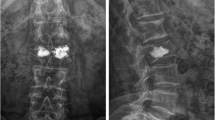Abstract
Introduction
The aims of this study are to describe non-healing in the treated vertebral body after percutaneous vertebroplasty and analyze the influence of vacuum cleft, location, and severity of collapse on the development of nonunion cement.
Materials and methods
Of 208 patients (266 treated vertebral bodies) who were treated with percutaneous vertebroplasty from September 2002 to May 2006, 23 patients (41 treated levels) with residual or recurrent pain underwent follow-up magnetic resonance imaging (MRI) study. Retrospective chart review with analysis of preoperative and postoperative MRIs were performed in these 23 patients.
Results
In the 41 treated vertebral bodies, 22 of 41 bodies had vacuum cleft found in the preoperative MRI study. Eight of the 22 treated vertebral bodies with preoperative vacuum clefts were found to have fluid between the interface of cement and the residual bone in the collapsed vertebral bodies on follow-up MRI. The adjacent discs of these treated vertebral bodies were upward/downward displaced. The endplate of the adjacent vertebral body exhibited fibrotic change. Treated bodies with vacuum clefts and level A location (T9, T11, T12, and L1) had higher probability of developing nonunion of the cement with statistical significance. The probability of nonunion cement in severe collapsed bodies might be higher than that of union cement in mild collapsed ones, but was not statistically significant.
Conclusions
Fluid sign in the treated body represents unhealed bone-cement interface. The location of the treated vertebral body and existence of vacuum cleft in the treated bodies may be important factors influencing the nonunion of cement.



Similar content being viewed by others
References
Jensen ME, Kallmes DF, Schweicker PA, et al. (1999) Percutaneous vertebroplasty does not increase the risk of adjacent vertebral fractures. Presented at the 37th annual meeting of American Society of Neuroradiology, San Diego, CA
Gaughen JR, Jensen ME, Schweickert PA et al (2002) The therapeutic benefit of repeat percutaneous vertebroplasty at the previously treated vertebral levels. AJNR Am J Neuroradiol 23:1657–1661
Lin CC, Chen IH, Yu TC et al (2007) New symptomatic compression fracture after percutaneous vertebroplasty at the thoracolumbar junction. AJNR Am J Neuroradiol 28:1042–1045
Dansie DM, Luetmer PH, Lane JI et al (2005) MRI findings after successful vertebroplasty. AJNR Am J Neuroradiol 26:1595–1600
Kwon BK, Vaccaro AR, Grauer JN et al (2003) Indications, techniques, and outcomes of posterior surgery for chronic low back pain. Orthop Clin N Am 34:297–308
Tsai TT, Chen WJ, Lai PL et al (2003) Polymethylmethacrylate cement dislodgment following percutaneous vertebroplasty: a case report. Spine 28:E457–E460
Wagner AL, Baskurt E (2006) Refracture with cement extrusion following percutaneous vertebroplasty of a large interbody cleft. AJNR Am J Neuroradiol 27:230–231
Lane JI, Maus TP, Wald JT et al (2002) Intravertebral clefts opacified during vertebroplasty: pathogenesis, technical implications, and prognostic significance. AJNR Am J Neuroradiol 23:1642–1646
Wiggins MC, Sehizadeh M, Pilgram TK et al (2007) Importance of intravertebral fracture clefts in vertebroplasty outcome. AJR Am J Roentgenol 188:634–640
Deramond H, Wright NT, Belkoff SM (1999) Temperature elevation caused by bone cement polymerization during vertebroplasty. Bone 25:17S–21S
Danilewicz-Stysiak Z (1980) Experimental investigations on the cytotoxic nature of methyl methacrylate. J Prosthet Dent 44:13–16
Belkoff SM, Mathis JM, Jasper LE et al (2001) The biomechanics of vertebroplasty. The effect of cement volume on mechanical behavior. Spine 26:1537–1541
Maldague BE, Noel HM, Malghem JJ (1978) The intravertebral vacuum cleft: a sign of ischemic vertebral collapse. Radiology 129:23–29
Kim DY, Lee SH, Jang JS et al (2004) Intravertebral vacuum phenomenon in osteoporotic compression fracture: report of 67 cases with quantitative evaluation of intravertebral instability. J Neurosurg 100(1 Suppl Spine):24–31
Hasegawa K, Homma T, Uchiyama S et al (1998) Vertebral pseudarthrosis in the osteoporotic spine. Spine 23:2201–2206
Baur A, Stabler A, Arbogast S et al (2002) Acute osteoporotic and neoplastic vertebral compression fractures: fluid sign at MR imaging. Radiology 225:730–735
Malghem J, Maldague B, Labaisse MA et al (1993) Intravertebral vacuum cleft: changes in content after supine positioning. Radiology 187:483–487
Conflict of interest statement
We declare that we have no conflict of interest.
Author information
Authors and Affiliations
Corresponding author
Rights and permissions
About this article
Cite this article
Lin, CC., Yen, PS. & Wen, SH. Fluid sign in the treated bodies after percutaneous vertebroplasty. Neuroradiology 50, 955–961 (2008). https://doi.org/10.1007/s00234-008-0430-6
Received:
Accepted:
Published:
Issue Date:
DOI: https://doi.org/10.1007/s00234-008-0430-6




